The Recycling of Acid Wastewater with High Concentrations of Organic Matter: Recovery of H2SO4 and Preparation of Activated Carbon
Abstract
:1. Introduction
2. Materials and Methods
2.1. Materials
2.2. Experimental Methods
2.2.1. Heat Treatment and Separation of Sulfuric Acid from Organic Matter
2.2.2. Preparation of Activated Carbon
2.3. Analysis Methods
3. Results and Discussion
3.1. Separation of Sulfuric Acid from Organic Matter
3.2. Preparation of Activated Carbon from Residual Solid Organic Matter
3.2.1. Effect of Alkali/Carbon Ratio
3.2.2. Effect of Activation Temperature
3.2.3. Effect of Impregnation Time
3.2.4. Effect of Washing
3.3. Characterization of the Activated Carbon
3.4. The Activated Carbon Yield and Alkali Consumption
3.5. Comparative Adsorption Capacity with Respect to Other Activated Carbon
4. Conclusions
Author Contributions
Funding
Institutional Review Board Statement
Informed Consent Statement
Conflicts of Interest
References
- Main Sources, Application Status, New Disposal and Utilization Techniques of Waste Sulfuric Acid in China. Available online: http://www.51gufei.com/news/show.php?itemid=469 (accessed on 1 April 2020).
- Wei, Q.; Ren, X.; Guo, J.; Chen, Y. Recovery and separation of sulfuric acid and iron from dilute acidic sulfate effluent and waste sulfuric acid by solvent extraction and stripping. J. Hazard. Mater. 2016, 304, 1–9. [Google Scholar]
- Secretly Discharge Waste Sulfuric Acid by Enterprises Causing Frequent Pollution Cases in China. Available online: http://www.51gufei.com/news/show.php?itemid=470 (accessed on 1 April 2020).
- Rosocka, M.R. A review on methods of regeneration of spent pickling solutions from steel processing. J. Hazard. Mater. 2010, 177, 57–69. [Google Scholar] [CrossRef] [PubMed]
- Zhou, Z.; Zhang, X.; Yang, F.; Zhang, S. Polymeric carbon material from waste sulfuric acid of alkylation and its application in biodiesel production. J. Clean. Prod. 2019, 215, 13–21. [Google Scholar] [CrossRef]
- Malins, K.; Kampars, V.; Brinks, J.; Neibolte, I.; Murnieks, R. Synthesis of activated carbon based heterogenous acid catalyst for biodiesel preparation. Appl. Catal. B Environ. 2015, 176–177, 553–558. [Google Scholar] [CrossRef]
- Naji, S.Z.; Tye, C.T. A review of the synthesis of activated carbon for biodiesel production: Precursor, preparation, and modification. Energy Convers. Manag. X 2022, 13, 100152. [Google Scholar] [CrossRef]
- Zhang, D.; Lin, X.; Zhang, Q.; Ren, X.; Yu, W.; Cai, H. Catalytic pyrolysis of wood-plastic composite waste over activated carbon catalyst for aromatics production: Effect of preparation process of activated carbon. Energy 2020, 212, 118983. [Google Scholar] [CrossRef]
- Cazetta, A.L.; Vargas, A.M.M.; Nogami, E.M.; Kunita, M.H.; Guilherme, M.R.; Martins, A.C.; Silva, T.L.; Moraes, J.C.; Almeida, V.C. NaOH-activated carbon of high surface area produced from coconut shell: Kinetics and equilibrium studies from the methylene blue adsorption. Chem. Eng. J. 2011, 174, 117–125. [Google Scholar] [CrossRef]
- Zhang, D.; Yin, J.; Zhao, J.; Zhu, H.; Wang, C. Adsorption and removal of tetracycline from water by petroleum coke-derived highly porous activated carbon. J. Environ. Chem. Eng. 2015, 3, 1504–1512. [Google Scholar] [CrossRef]
- Takuya, M.; Mitsuhiro, K.; Hitoki, M.; Luis, F.D.C. Adsorption behaviors of ammonia and hydrogen sulfide on activated carbon prepared from petroleum coke by KOH chemical activation. Fuel Process. Technol. 2016, 144, 164–169. [Google Scholar]
- Basta, A.H.; Fierro, V.; Elsaied, H.; Celzard, A. 2-Steps KOH activation of rice straw: An efficient method for preparing high-performance activated carbons. Bioresour. Technol. 2009, 100, 3941–3947. [Google Scholar] [CrossRef] [PubMed]
- APHA Standard Methods for the Examination of Water and Wastewater, 21st ed.; American Water Works Association and Water Environment Federation: Washington, DC, USA, 2005.
- PRC National Standard for Wooden Activated Carbon for Water Purification, GBT 13803.2-1999; State Bureau of Quality Technical Supervision: Beijing, China, 1999.
- PRC National Standard for Test Methods of Wooden Activated Carbon-Determination of Iodine Number, GB/T 12496.8-2015; The China National Standardization Management Committee: Beijing, China, 2015.
- PRC National Standard for Test Methods of Wooden Activated Carbon--Determination of Methylene Blue Adsorption, GB/T 12496.10-1999; State Bureau of Quality Technical Supervision: Beijing, China, 1999.
- Bag, O.; Tekin, K.; Karagoz, S. Microporous activated carbons from lignocellulosic biomass by KOH activation. Fuller. Nanotub. Carbon Nanostruct. 2020, 28, 1030–1037. [Google Scholar] [CrossRef]
- Norouzi, S.; Heidari, M.; Alipour, V.; Rahmanian, O.; Fazlzadeh, M.; Mohammadi-moghadam, F.; Nourmoradi, H.; Goudarzi, B.; Dindarloo, K. Preparation, characterization and Cr(VI) adsorption evaluation of NaOH-activated carbon produced from Date Press Cake; an agro-industrial waste. Bioresour. Technol. 2018, 258, 48–56. [Google Scholar] [CrossRef]
- Li, Z.; Wang, G.; Zhai, K.; He, C.; Li, Q.; Guo, P. Methylene blue adsorption from aqueous solution by loofah sponge-based porous carbons. Colloids Surf. A Physicochem. Eng. Asp. 2018, 538, 28–35. [Google Scholar] [CrossRef]
- Wu, J.F.; Montes, V.; Virla, L.D.; Hill, J.M. Impacts of amount of chemical agent and addition of steam for activation of petroleum coke with KOH or NaOH. Fuel Process. Technol. 2018, 181, 53–60. [Google Scholar] [CrossRef]
- Liew, R.K.; Azwar, E.; Yek, P.N.Y.; Lim, X.Y.; Cheng, C.K.; Ng, J.H.; Jusoh, A.; Lam, W.H.; Ibrahim, M.D.; Ma, N.L.; et al. Microwave pyrolysis with KOH/NaOH mixture activation: A new approach to produce micro-mesoporous activated carbon for textile dye adsorption. Bioresour. Technol. 2018, 266, 1–10. [Google Scholar] [CrossRef]
- Li, S.J.; Han, K.H.; Li, J.X.; Li, M.; Lu, C.M. Preparation and characterization of super activated carbon produced from gulfweed by KOH activation. Micropor. Mesopor. Mat. 2017, 243, 291–300. [Google Scholar] [CrossRef]
- Lu, C.; Xu, S.; Gan, Y.; Liu, S.; Liu, C. Effect of pre-carbonization of petroleum cokes on chemical activation process with KOH. Carbon 2005, 43, 2295–2301. [Google Scholar]
- Mariana, M.; Eka Marya, M.; Tata, A.; Muhammad Dani, S. High-porous activated carbon derived from Myristica fragrans shell using one-step KOH activation for methylene blue adsorption. Bioresour. Technol. Rep. 2021, 16, 100845. [Google Scholar] [CrossRef]
- Yang, X.; Wang, Q.; Lai, J.; Cai, Z.; Lv, J.; Chen, X.; Chen, Y.; Zheng, X.; Huang, B.; Lin, G. Nitrogen-doped activated carbons via melamine-assisted NaOH/KOH/urea aqueous system for high performance supercapacitors. Mater. Chem. Phys. 2020, 250, 123201. [Google Scholar] [CrossRef]
- Lu, C.; Xu, S.; Liu, C. The role of K2CO3 during the chemical activation of petroleum coke with KOH. J. Anal. Appl. Pyrol. 2010, 87, 282–287. [Google Scholar] [CrossRef]
- Lillo-Ródenas, M.A.; Cazorla-Amorós, D.; Linares-Solano, A. Understanding chemical reactions between carbons and NaOH and KOH: An insight into the chemical activation mechanism. Carbon 2003, 41, 267–275. [Google Scholar] [CrossRef]
- Foo, K.Y.; Hameed, B.H. Coconut husk derived activated carbon via microwave induced activation: Effects of activation agents, preparation parameters and adsorption performance. Chem. Eng. J. 2012, 184, 57–65. [Google Scholar] [CrossRef]
- Marrakchi, F.; Ahmed, M.J.; Khanday, W.A.; Asif, M.; Hameed, B.H. Mesoporous activated carbon prepared from chitosan flakes via single-step sodium hydroxide activation for the adsorption of methylene blue. Int. J. Biol. Macromol. 2017, 98, 233–239. [Google Scholar] [CrossRef]
- Khanday, W.A.; Marrakchi, F.; Asif, M.; Hameed, B.H. Mesoporous zeolite–activated carbon composite from oil palm ash as an effective adsorbent for methylene blue. J. Taiwan Inst. Chem. Eng. 2017, 70, 32–41. [Google Scholar] [CrossRef]
- Jawad, A.H.; Abdulhameed, A.S. Statistical modeling of methylene blue dye adsorption by high surface area mesoporous activated carbon from bamboo chip using KOH-assisted thermal activation. Energy Ecol. Environ. 2020, 5, 456–469. [Google Scholar] [CrossRef]
- Tran, T.H.; Le, A.H.; Pham, T.H.; Nguyen, D.T.; Chang, S.W.; Chung, W.J.; Nguyen, D.D. Adsorption isotherms and kinetic modeling of methylene blue dye onto a carbonaceous hydrochar adsorbent derived from coffee husk waste. Sci. Total Environ. 2020, 725, 138325. [Google Scholar] [CrossRef] [PubMed]
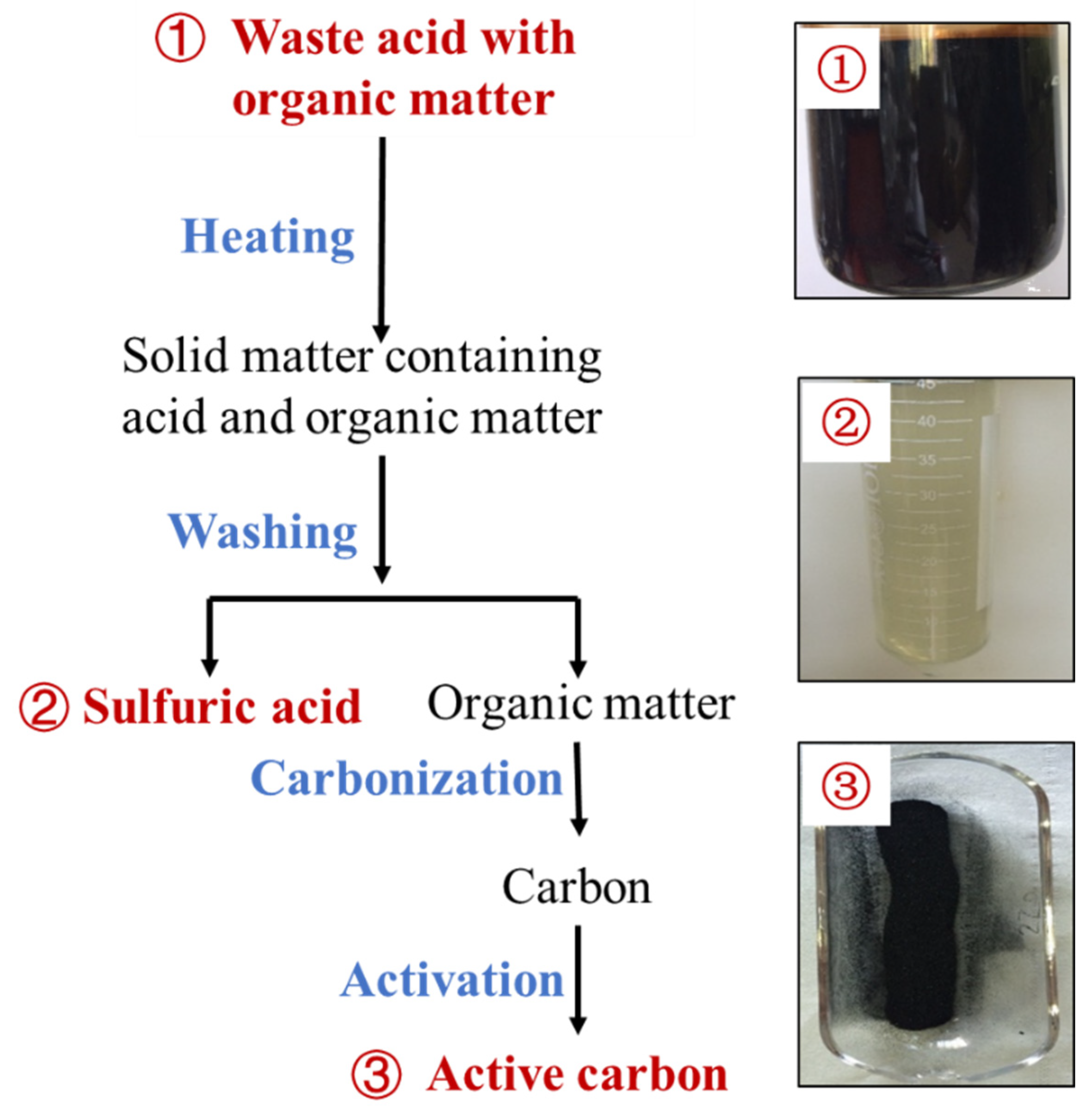
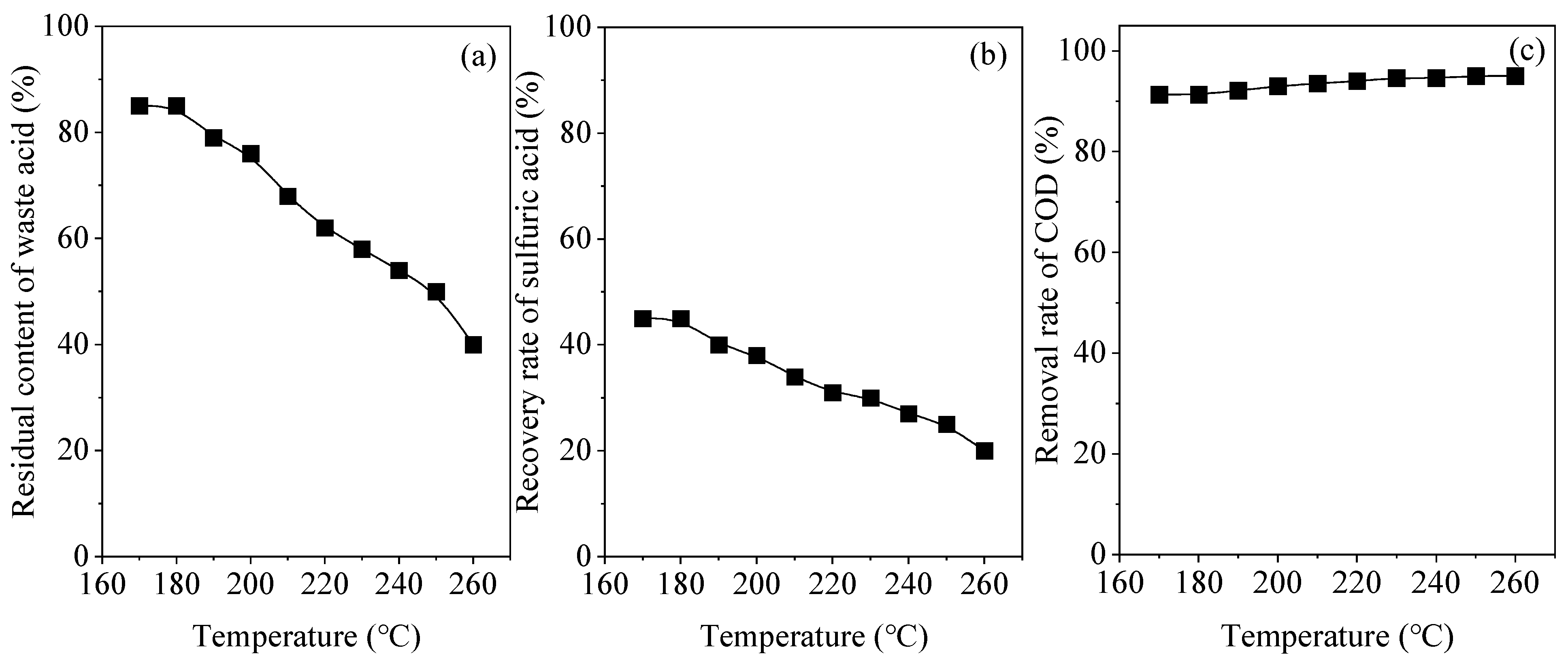
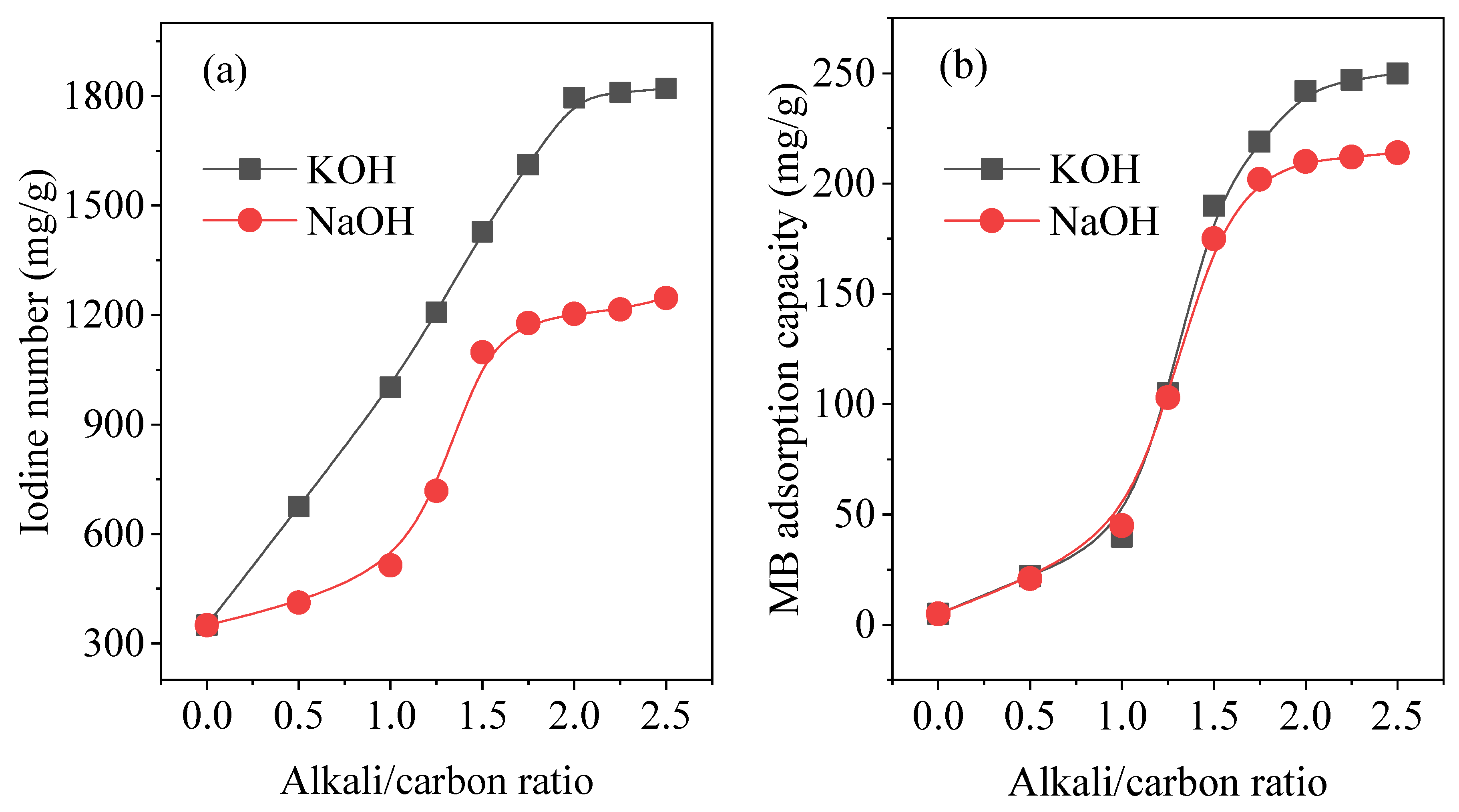

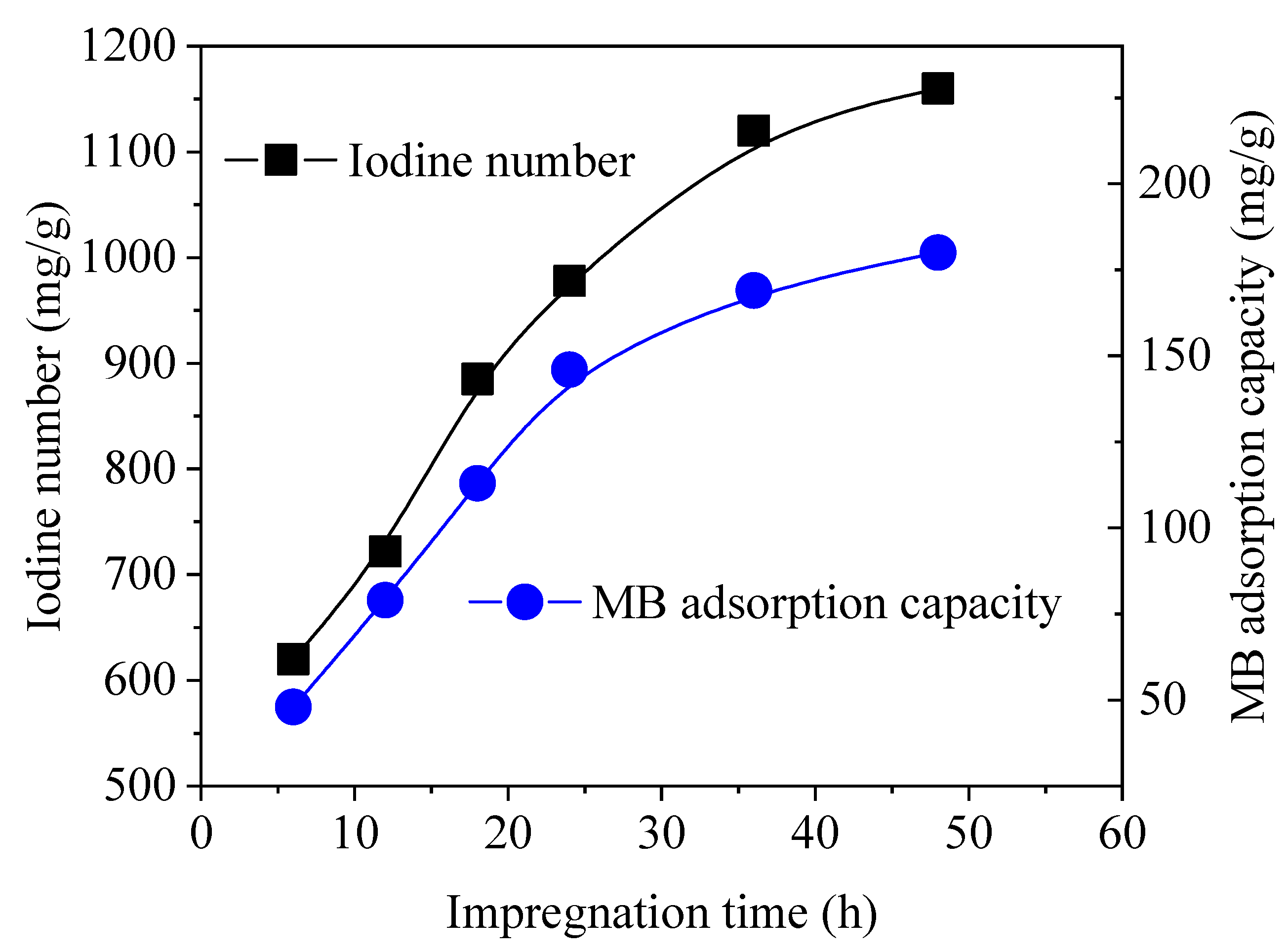
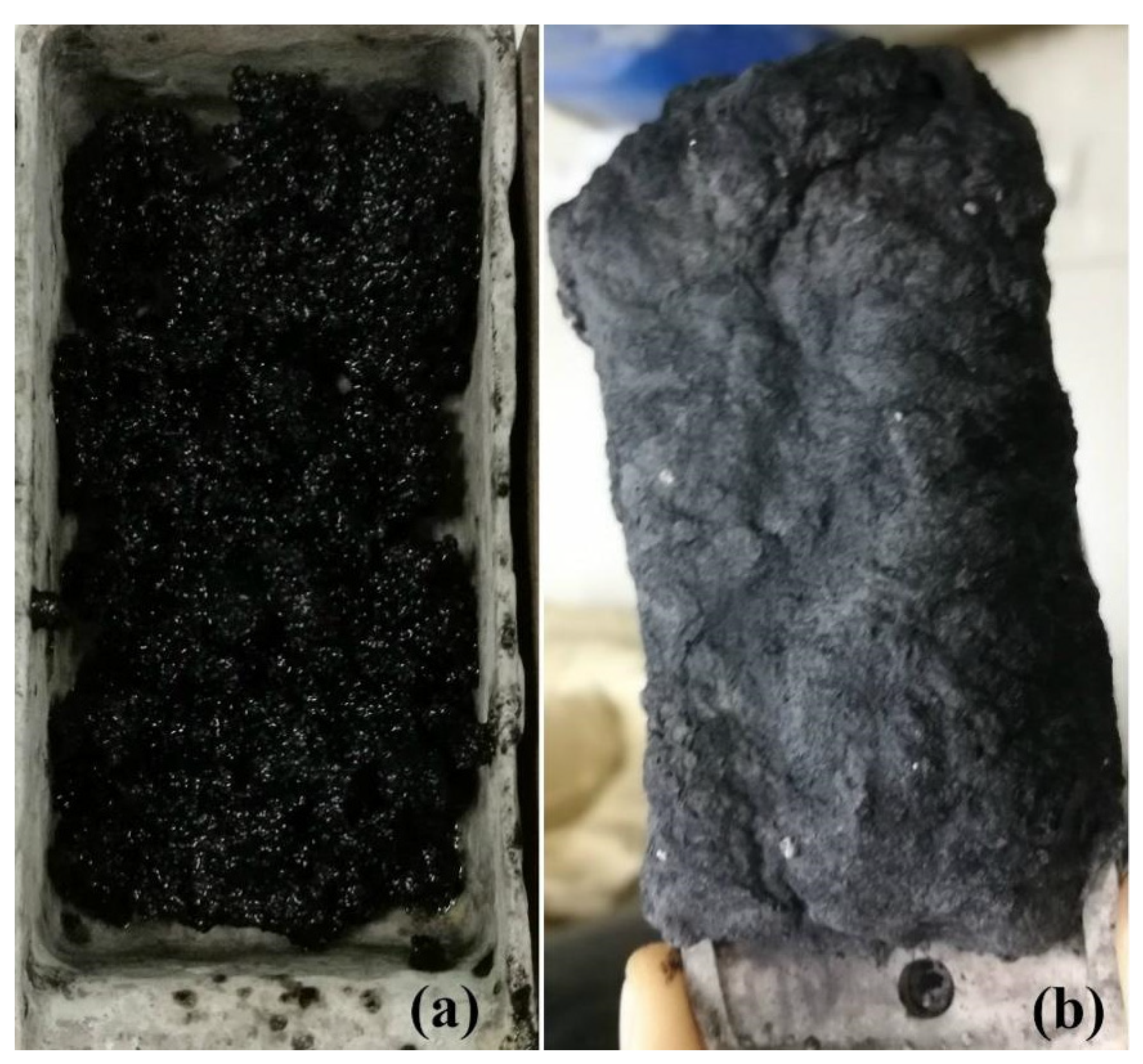

| Activated Carbon Precursor | Experimental Conditions of AC Activation | BET Surface Area (m2/g) | Experimental Conditions of MB Adsorption | MB Adsorption Capacity (mg/g) | References | ||
|---|---|---|---|---|---|---|---|
| Activating Agent | Activation Time (min) | Temperature (°C) | pH | ||||
| Loofah sponge | NaOH | 60 | 733 | 30 | 11 | 210.97 | [19] |
| Chitosan flakes | NaOH | 90 | 318.40 | 50 | 11 | 143.53 | [29] |
| Oil palm ash | NaOH | 90 | 615.406 | 50 | N.A | 285.71 | [30] |
| Acid waste | NaOH | 60 | 1065 | 25 | 7 | 200 | This study |
| Bamboo chip | KOH | 60 | 720.69 | 40 | 10 | 305.3 | [31] |
| Coffee husk | KOH | 120 | 862.2 | 30 | 7 | 418.78 | [32] |
| Acid waste | KOH | 60 | 1230 | 25 | 7 | 240 | This study |
Publisher’s Note: MDPI stays neutral with regard to jurisdictional claims in published maps and institutional affiliations. |
© 2022 by the authors. Licensee MDPI, Basel, Switzerland. This article is an open access article distributed under the terms and conditions of the Creative Commons Attribution (CC BY) license (https://creativecommons.org/licenses/by/4.0/).
Share and Cite
Hu, X.; Kong, L.; Zhu, F.; Peng, X. The Recycling of Acid Wastewater with High Concentrations of Organic Matter: Recovery of H2SO4 and Preparation of Activated Carbon. Water 2022, 14, 183. https://doi.org/10.3390/w14020183
Hu X, Kong L, Zhu F, Peng X. The Recycling of Acid Wastewater with High Concentrations of Organic Matter: Recovery of H2SO4 and Preparation of Activated Carbon. Water. 2022; 14(2):183. https://doi.org/10.3390/w14020183
Chicago/Turabian StyleHu, Xingyun, Linghao Kong, Feng Zhu, and Xianjia Peng. 2022. "The Recycling of Acid Wastewater with High Concentrations of Organic Matter: Recovery of H2SO4 and Preparation of Activated Carbon" Water 14, no. 2: 183. https://doi.org/10.3390/w14020183
APA StyleHu, X., Kong, L., Zhu, F., & Peng, X. (2022). The Recycling of Acid Wastewater with High Concentrations of Organic Matter: Recovery of H2SO4 and Preparation of Activated Carbon. Water, 14(2), 183. https://doi.org/10.3390/w14020183





